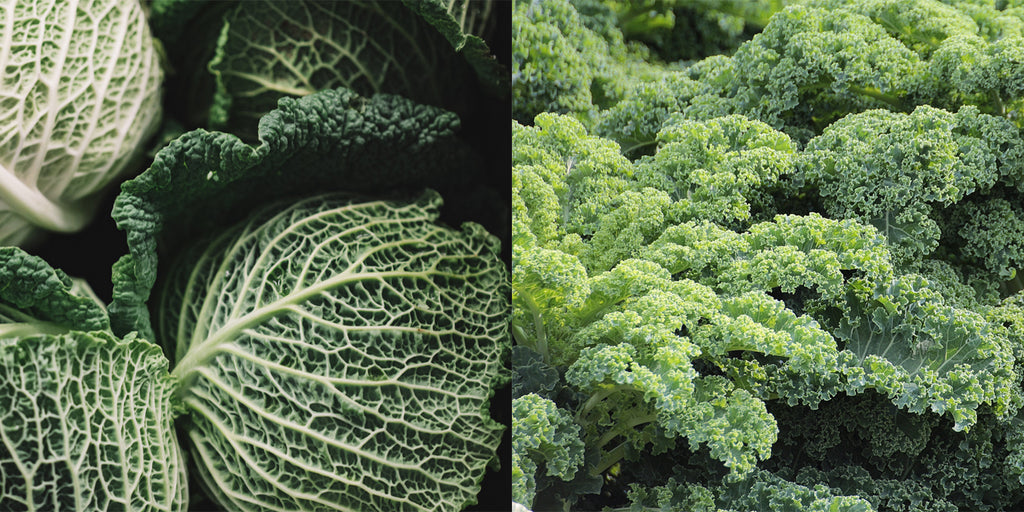Εξερευνώντας τον Κόσμο των Φυλλωδών Λαχανικών: Ένας Ολοκληρωμένος Οδηγός για το Καλέ και το Λάχανο

Στον απέραντο κόσμο των φυλλωδών λαχανικών, το λάχανο και το κουνουπίδι ξεχωρίζουν ως ευέλικτα και θρεπτικά βασικά στοιχεία που έχουν μαγέψει τους ουρανίσκους και έχουν θρέψει πολιτισμούς για αιώνες. Αυτός ο ολοκληρωμένος οδηγός εμβαθύνει στον πολυδιάστατο κόσμο του λάχανου και του κουνουπιδιού, εξερευνώντας την πλούσια ιστορία τους, το διατροφικό τους περιεχόμενο, τις μαγειρικές χρήσεις και τις μεθόδους καλλιέργειας. Από τους αρχαίους πολιτισμούς της Ελλάδας και της Ρώμης μέχρι τις σύγχρονες κουζίνες σε όλο τον κόσμο, το λάχανο και το κουνουπίδι παραμένουν σταθερές προτιμήσεις, γιορτάζοντας τις έντονες γεύσεις και τις υγιεινές τους ιδιότητες. Ελάτε μαζί μας σε ένα ταξίδι μέσα από το παρελθόν, το παρόν και το μέλλον αυτών των αγαπημένων φυλλωδών λαχανικών καθώς αποκαλύπτουμε τα μοναδικά τους χαρακτηριστικά και ξεκλειδώνουμε τα μυστικά για την καλλιέργεια και την απόλαυσή τους στο μέγιστο δυνατό.
Ιστορία του Λάχανου και του Κουνουπιδιού
Λάχανο: Το λάχανο έχει μακρά ιστορία καλλιέργειας, που χρονολογείται χιλιάδες χρόνια πίσω σε αρχαίους πολιτισμούς όπως οι Έλληνες και οι Ρωμαίοι. Ήταν βασική καλλιέργεια στην Ευρώπη κατά τον Μεσαίωνα και κέρδισε δημοτικότητα στη Βόρεια Αμερική τον 19ο αιώνα. Το λάχανο γνώρισε αναβίωση της δημοτικότητάς του τα τελευταία χρόνια λόγω της διατροφικής του αξίας και της ευελιξίας του στη μαγειρική.

Λάχανο: Το λάχανο καλλιεργείται εδώ και χιλιάδες χρόνια, με αποδείξεις κατανάλωσής του που χρονολογούνται από αρχαίους πολιτισμούς όπως οι Αιγύπτιοι, οι Έλληνες και οι Ρωμαίοι. Ήταν βασικό στοιχείο της διατροφής σε πολλές κουλτούρες παγκοσμίως και μεταφέρθηκε στην Αμερική από Ευρωπαίους αποίκους. Το λάχανο είναι επίσης γνωστό για τη χρήση του στην πρόληψη του σκορβούτου κατά τη διάρκεια μακρών θαλάσσιων ταξιδιών λόγω της υψηλής περιεκτικότητάς του σε βιταμίνη C.

Πώς να Καλλιεργήσετε Λάχανο και Κουνουπίδι:
Καλλιέργεια Λάχανου:
-
Κλίμα και Έδαφος: Το λάχανο ευδοκιμεί σε δροσερό καιρό και μπορεί να αντέξει την παγωνιά. Προτιμά καλά αποστραγγιζόμενο, γόνιμο έδαφος με pH μεταξύ 6,0 και 7,5.
-
Φύτευση: Φυτέψτε σπόρους λάχανου απευθείας στον κήπο ή ξεκινήστε τους σε εσωτερικούς χώρους 4-6 εβδομάδες πριν από την τελευταία αναμενόμενη ημερομηνία παγωνιάς. Απομακρύνετε τα φυτά 12-18 ίντσες το ένα από το άλλο σε σειρές.
-
Φροντίδα: Κρατήστε το έδαφος σταθερά υγρό, ειδικά κατά τις ξηρές περιόδους. Τοποθετήστε πολτό γύρω από τα φυτά για να διατηρείται η υγρασία και να καταστέλλονται τα ζιζάνια. Λιπάνετε με ισορροπημένο λίπασμα κάθε 4-6 εβδομάδες.
-
Συγκομιδή: Τα φύλλα του καλέ μπορούν να συγκομιστούν όταν φτάσουν στο επιθυμητό μέγεθος, συνήθως γύρω στις 8-12 ίντσες μήκος. Μαζέψτε φύλλα από το εξωτερικό μέρος του φυτού, αφήνοντας τα εσωτερικά φύλλα να συνεχίσουν να αναπτύσσονται.
Καλλιέργεια Λάχανου:
-
Κλίμα και Έδαφος: Το λάχανο προτιμά δροσερές θερμοκρασίες και μπορεί να αντέξει ελαφρύ παγετό. Αναπτύσσεται καλύτερα σε καλά αποστραγγιζόμενο, γόνιμο έδαφος με pH μεταξύ 6,0 και 7,5.
-
Φύτευση: Ξεκινήστε τους σπόρους λάχανου σε εσωτερικούς χώρους 6-8 εβδομάδες πριν από την τελευταία αναμενόμενη ημερομηνία παγετού ή σπείρετέ τους απευθείας στον κήπο. Αποστάσεις φυτών 12-24 ίντσες μεταξύ τους σε σειρές.
-
Φροντίδα: Κρατήστε το έδαφος σταθερά υγρό, ειδικά στα πρώτα στάδια ανάπτυξης. Το λάχανο ωφελείται από τακτικό πότισμα και μια στρώση πολτού για να διατηρεί την υγρασία και να ελέγχει τα ζιζάνια. Λιπάνετε με ισορροπημένο λίπασμα κάθε 3-4 εβδομάδες.
-
Συγκομιδή: Συγκομίστε τα κεφάλια λάχανου όταν φτάσουν στο πλήρες μέγεθος και είναι σφιχτά στην αφή. Κόψτε το κεφάλι από το στέλεχος, αφήνοντας μερικά εξωτερικά φύλλα προσαρτημένα για να προστατεύουν τα εσωτερικά φύλλα κατά την αποθήκευση.
Ακολουθώντας αυτές τις οδηγίες, μπορείτε να καλλιεργήσετε επιτυχώς καλέ και λάχανο στον κήπο σας, παρέχοντάς σας φρέσκα και θρεπτικά λαχανικά για να απολαμβάνετε καθ'όλη τη διάρκεια της καλλιεργητικής περιόδου.

Το καλέ και το λάχανο είναι και τα δύο φυλλώδη λαχανικά που ανήκουν στο γένος Brassica της οικογένειας Brassicaceae, κοινώς γνωστής ως οικογένεια λάχανου ή μουστάρδας. Παρόλο που έχουν κάποιες ομοιότητες, υπάρχουν αρκετές διαφορές μεταξύ καλέ και λάχανου:
-
Εμφάνιση:
- Καλέ: Τα φύλλα του καλέ είναι συνήθως σκούρα πράσινα ή μωβ και έχουν σγουρή ή κυματιστή υφή. Υπάρχουν διάφορες ποικιλίες καλέ, όπως το σγουρό καλέ, το τοσκάνικο καλέ (γνωστό και ως δεινοσαυροκαλέ ή Lacinato καλέ) και το κόκκινο καλέ.
- Λάχανο: Το λάχανο έχει μεγάλα, στρογγυλά ή οβάλ κεφάλια που αποτελούνται από σφιχτά πακεταρισμένα φύλλα. Τα εξωτερικά φύλλα είναι συνήθως πράσινα, ενώ τα εσωτερικά μπορεί να είναι λευκά, κόκκινα ή μωβ, ανάλογα με την ποικιλία.
-
Υφή και Γεύση:
- Καλέ: Τα φύλλα του καλέ είναι σχετικά σκληρά και έχουν ανθεκτική υφή, ειδικά όταν είναι ωμά. Έχουν ελαφρώς πικρή γεύση, ιδιαίτερα τα παλαιότερα φύλλα, και μπορεί να είναι κάπως μαστιχωτά.
- Λάχανο: Τα φύλλα του λάχανου είναι πιο μαλακά και τρυφερά σε σύγκριση με το καλέ. Η γεύση του λάχανου μπορεί να διαφέρει ανάλογα με την ποικιλία, αλλά γενικά είναι πιο ήπια και γλυκύτερη από το καλέ, ειδικά όταν μαγειρεύεται.
-
Διατροφικό Περιεχόμενο:
- Καλέ: Το καλέ συχνά επαινείται για τη διατροφική του αξία και θεωρείται υπερτροφή. Είναι πλούσιο σε βιταμίνες A, C και K, καθώς και σε μέταλλα όπως ασβέστιο, κάλιο και σίδηρο. Το καλέ είναι επίσης καλή πηγή αντιοξειδωτικών και ινών.
- Λάχανο: Το λάχανο είναι επίσης θρεπτικό αλλά γενικά έχει χαμηλότερα επίπεδα ορισμένων βιταμινών και μετάλλων σε σύγκριση με το καλέ. Είναι καλή πηγή βιταμινών C και K και παρέχει ίνες και διάφορα φυτοθρεπτικά συστατικά.
-
Χρήσεις στη Μαγειρική:
- Kale: Το kale μπορεί να καταναλωθεί ωμό σε σαλάτες ή μαγειρεμένο σε διάφορα πιάτα όπως σούπες, στιφάδο, stir-fries ή σοταρισμένο. Μπορεί επίσης να ψηθεί σε τσιπς kale ή να αναμειχθεί σε smoothies.
- Λάχανο: Το λάχανο χρησιμοποιείται συνήθως σε κολσλάου, σαλάτες και ζυμωμένα τρόφιμα όπως το ξινολάχανο και το kimchi. Μπορεί επίσης να μαγειρευτεί σε πιάτα όπως stir-fries, σούπες, στιφάδο ή γεμιστά λάχανα.
-
Καλλιέργεια:
- Kale: Το kale είναι ένα ανθεκτικό στο κρύο φυλλώδες πράσινο που μπορεί να αντέξει σε παγετό, καθιστώντας το κατάλληλο για καλλιέργεια σε πιο δροσερά κλίματα. Είναι διετές φυτό αλλά συνήθως καλλιεργείται ως ετήσιο.
- Λάχανο: Το λάχανο είναι επίσης ανθεκτικό στο κρύο και μπορεί να καλλιεργηθεί σε διάφορα κλίματα, αλλά προτιμά πιο δροσερές θερμοκρασίες. Συνήθως καλλιεργείται ως ετήσιο και συγκομίζεται όταν το κεφάλι έχει σχηματιστεί πλήρως.
Συνολικά, ενώ το λάχανο kale και το λάχανο είναι και τα δύο θρεπτικά φυλλώδη λαχανικά, έχουν διακριτές διαφορές στην εμφάνιση, την υφή, τη γεύση, τις γαστρονομικές χρήσεις και τις απαιτήσεις καλλιέργειας.

Το λάχανο διατίθεται σε διάφορα χρώματα, συμπεριλαμβανομένων του πράσινου, του κόκκινου (επίσης γνωστού ως μωβ ή κόκκινο λάχανο) και του λάχανου Σαβοΐας (που έχει τσαλακωμένα φύλλα και ανοιχτό πράσινο χρώμα). Τα διαφορετικά χρώματα του λάχανου οφείλονται κυρίως σε παραλλαγές στο περιεχόμενο των χρωστικών τους, συγκεκριμένα ανθοκυανινών και χλωροφύλλης.
-
Πράσινο Λάχανο:
- Το πράσινο λάχανο είναι η πιο κοινή ποικιλία και είναι γνωστό για τα ανοιχτό έως σκούρο πράσινα φύλλα του.
- Θρεπτικό Περιεχόμενο: Το πράσινο λάχανο είναι πλούσιο σε βιταμίνη C και παρέχει καλή ποσότητα βιταμίνης K. Περιέχει επίσης ίνες, φολικό οξύ, κάλιο και μικρότερες ποσότητες άλλων βιταμινών και μετάλλων.
-
Κόκκινο/Μωβ Λάχανο:
- Το κόκκινο λάχανο έχει ζωντανά μωβ ή κόκκινα φύλλα, που οφείλονται στην παρουσία ανθοκυανινών, ενός τύπου αντιοξειδωτικού χρωστικού.
- Θρεπτικό Περιεχόμενο: Το κόκκινο λάχανο περιέχει υψηλότερα επίπεδα ανθοκυανινών σε σύγκριση με το πράσινο λάχανο, καθιστώντας το πλουσιότερο σε αντιοξειδωτικά. Παρέχει επίσης παρόμοια θρεπτικά συστατικά με το πράσινο λάχανο, συμπεριλαμβανομένων της βιταμίνης C, της βιταμίνης K, των ινών και άλλων βιταμινών και μετάλλων.
-
Λάχανο Σαβοΐας:
- Το λάχανο Σαβοΐας έχει τσαλακωμένα ή σγουρά φύλλα και πιο ανοιχτό πράσινο χρώμα σε σύγκριση με άλλες ποικιλίες λάχανου.
- Θρεπτικό Περιεχόμενο: Το λάχανο Σαβοΐας έχει παρόμοιο θρεπτικό περιεχόμενο με το πράσινο λάχανο, προσφέροντας βιταμίνες C και K, ίνες και άλλα θρεπτικά συστατικά.
Τα διαφορετικά χρώματα του λάχανου όχι μόνο προσφέρουν οπτική ποικιλία αλλά και διάφορα φυτοθρεπτικά συστατικά και αντιοξειδωτικά, συμβάλλοντας στα θρεπτικά τους οφέλη. Η ένταξη ποικιλίας χρωμάτων λάχανου στη διατροφή σας μπορεί να παρέχει ευρύτερο φάσμα θρεπτικών συστατικών και ενώσεων που προάγουν την υγεία.

Το λάχανο kale, γνωστό για την υψηλή θρεπτική του αξία και τη γαστρονομική του ευελιξία, διατίθεται επίσης σε διάφορα χρώματα, το καθένα προσφέροντας το μοναδικό του προφίλ γεύσης και οπτικής έλξης.
-
Πράσινο Καλέ:
- Το πράσινο καλέ, η πιο κοινή ποικιλία, έχει ζωντανά σκούρα πράσινα φύλλα με ελαφρώς ρυτιδωμένη υφή. Είναι πλούσιο σε βιταμίνες A, C και K, καθώς και σε μέταλλα όπως ασβέστιο και σίδηρο. Με ελαφρώς πικρή γεύση, το πράσινο καλέ είναι ιδανικό για σοτάρισμα, ατμιστό ή για να προστεθεί ωμό σε σαλάτες.
-
Κόκκινο ή Μωβ Καλέ:
- Το κόκκινο ή μωβ καλέ, γνωστό και ως ρωσικό καλέ, παρουσιάζει εντυπωσιακούς μωβ-κόκκινους μίσχους και φύλλα με βαθύ μωβ χρώμα. Αυτή η ποικιλία περιέχει ανθοκυανίνες, ισχυρά αντιοξειδωτικά που συμβάλλουν στο ζωντανό χρώμα και τα πιθανά οφέλη για την υγεία. Το κόκκινο καλέ έχει πιο ήπια γεύση σε σύγκριση με το πράσινο και μπορεί να χρησιμοποιηθεί σε σαλάτες, τηγανιτά ή ως γαρνιτούρα για πιάτα.
-
Λασινάτο Καλέ (Δεινοσαυροκαλέ):
- Το λασινάτο καλέ, γνωστό και ως δεινοσαυροκαλέ ή τοσκάνικο καλέ, ξεχωρίζει με τα μακριά, στενά, μπλε-πράσινα φύλλα του που έχουν ανώμαλη υφή που μοιάζει με δέρμα δεινοσαύρου. Αυτή η παραδοσιακή ποικιλία προσφέρει πιο γλυκιά και λεπτή γεύση σε σύγκριση με το σγουρό καλέ, καθιστώντας το δημοφιλές για ωμές σαλάτες, smoothies ή ελαφρώς σοταρισμένα πιάτα.
-
Σγουρό Καλέ:
- Το σγουρό καλέ έχει σφιχτά ριγέ φύλλα και βαθύ πράσινο χρώμα. Έχει ανθεκτική υφή και ελαφρώς πιπεράτη γεύση, καθιστώντας το κατάλληλο για σούπες, στιφάδα και χορταστικά πιάτα. Τα σγουρά φύλλα του καλέ το κάνουν επίσης ελκυστικό γαρνίρισμα για σερβίρισμα.
-
Λευκό Καλέ:
- Το λευκό καλέ, γνωστό και ως πορτογαλικό καλέ ή καλέ μπαστούνι, έχει πλατιά, επίπεδα φύλλα με ανοιχτοπράσινους ή λευκούς μίσχους. Αυτή η λιγότερο γνωστή ποικιλία προσφέρει πιο ήπια γεύση και τρυφερή υφή, καθιστώντας την κατάλληλη για σαλάτες, ατμιστά ή σοταρισμένα πιάτα.
Ενσωματώνοντας διάφορα χρώματα καλέ στη διατροφή σας, μπορείτε όχι μόνο να απολαύσετε μια ποικιλία γεύσεων και υφών, αλλά και να μεγιστοποιήσετε την πρόσληψη βασικών θρεπτικών συστατικών και αντιοξειδωτικών. Είτε το απολαμβάνετε ωμό, μαγειρεμένο ή σε smoothies, οι ζωντανές αποχρώσεις και η θρεπτική αξία του καλέ το καθιστούν πολύτιμη προσθήκη σε κάθε γαστρονομικό ρεπερτόριο.

Περίληψη
Το λάχανο και το καλέ, μέλη του γένους Brassica, προσφέρουν πληθώρα θρεπτικών οφελών και γαστρονομική ευελιξία. Το καλέ, με τα σκούρα πράσινα ή μωβ σγουρά φύλλα του, θεωρείται υπερτροφή πλούσια σε βιταμίνες A, C και K, καθώς και σε μέταλλα όπως ασβέστιο και σίδηρο. Η ελαφρώς πικρή γεύση και η ανθεκτική υφή του το καθιστούν ιδανικό για ωμές σαλάτες ή μαγειρεμένα πιάτα. Από την άλλη, το λάχανο, διαθέσιμο σε πράσινες, κόκκινες και σαβοϊκές ποικιλίες, έχει τρυφερά φύλλα και πιο ήπια, γλυκιά γεύση. Πλούσιο σε βιταμίνη C και αντιοξειδωτικά, το λάχανο ταιριάζει καλά σε κολσλάου, σαλάτες και ζυμωμένα πιάτα όπως το ξινολάχανο. Όσον αφορά την καλλιέργεια, και τα δύο φυτά ευδοκιμούν σε δροσερό κλίμα και καλά αποστραγγιζόμενο έδαφος, αν και το καλέ είναι πιο ανθεκτικό στον παγετό. Είτε μαζεύετε τα ανθεκτικά φύλλα του καλέ είτε τα συμπαγή κεφάλια του λάχανου, αυτά τα φυλλώδη λαχανικά προσφέρουν μια θρεπτική προσθήκη σε κάθε διατροφή και έναν γευστικό καμβά για γαστρονομική εξερεύνηση.
Σχετικά θέματα:
















Αφήστε ένα σχόλιο